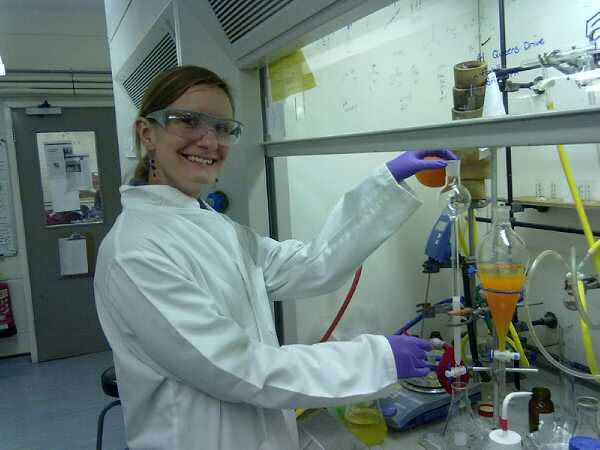

CD38 bound to hydrolysed cADPR analogue

Joanna Watt
MChem, PhD, MRSC
Visiting Research Associate
- Based at the University of Bath
My research uses synthetic chemistry to design molecules that will help us study calcium signalling in human cells.
Cell signalling forms part of vital processes, including cell division, fertilization and cell death. It is often dysfunctional in diseases like cancer, diabetes and inflammation. I hope that improving our understanding of these processes will also lead to new treatments for human disease.
I’m currently working on analogues of NAADP (Nicotinic Acid Adenine Dinucleotide Phosphate) – the most potent calcium releasing second messenger known to date. A combination of multiple negatively charged phosphate groups and the nicotinic acid make it both difficult to synthesize and challenging to study in biological systems.
I’m also continuing projects on the other nucleotide second messengers, ADPR (Adenosine DiPhosphate Ribose) and cADPR (cyclic-ADPR) to study their role in calcium release and their formation by CD38.
Journal Covers

Recent publications
-
Different substrate specificities of the two ADPR binding sites in TRPM2 channels of Nematostella vectensis and the role of IDPR.
Journal article
Kühn FJP. et al, (2019), Sci Rep, 9
-
Small Molecule Antagonists of NAADP-Induced Ca2+ Release in T-Lymphocytes Suggest Potential Therapeutic Agents for Autoimmune Disease.
Journal article
Zhang B. et al, (2018), Sci Rep, 8
-
Direct Activation of NADPH Oxidase 2 by 2-Deoxyribose-1-Phosphate Triggers Nuclear Factor Kappa B-Dependent Angiogenesis.
Journal article
Vara D. et al, (2018), Antioxid Redox Signal, 28, 110 - 130
-
Second messenger analogues highlight unexpected substrate sensitivity of CD38: total synthesis of the hybrid "L-cyclic inosine 5'-diphosphate ribose".
Journal article
Watt JM. et al, (2017), Sci Rep, 7
-
2'-Deoxyadenosine 5'-diphosphoribose is an endogenous TRPM2 superagonist.
Journal article
Fliegert R. et al, (2017), Nat Chem Biol, 13, 1036 - 1044
-
Visualizing context-dependent calcium signaling in encephalitogenic T cells in vivo by two-photon microscopy.
Journal article
Kyratsous NI. et al, (2017), Proc Natl Acad Sci U S A, 114, E6381 - E6389
-
Ligand-induced activation of human TRPM2 requires the terminal ribose of ADPR and involves Arg1433 and Tyr1349.
Journal article
Fliegert R. et al, (2017), Biochem J, 474, 2159 - 2175

